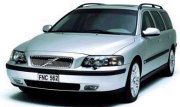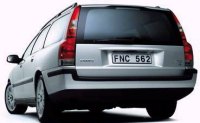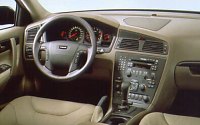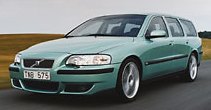  Count down: 80 - the flagship executive sedan without estate version; 70 - estate that looks nearly identical to the 80 but without sedan version; 60 - the even smaller sedan to be unveiled next year. All of them are derived from the same platform. In terms of dimensions, V70 is 30 mm narrower and 35 mm shorter in wheelbase than the S80, therefore Volvo refused to call it V80 instead. Well, is it enough to distinguish them ? 35 mm isn’t quite enough to insert two fingers into. So, in my opinion, V70 is still an S80 estate, though with a bit more deviations than industrial norm. And you know, the S80 is the best Volvo ever made.
Volvo revised the bushings of front MacPherson struts to reduce friction, hence delivering more steering feel than any other Volvo. Range-topping model T5 provides handling overshadowing most rivals bar BMW 5-series Touring and Mercedes E-class. It’s not tuned to be a really hard-edge sports wagon, just inject more power and dynamic while retaining good ride comfort, an evidence is given by the relatively high profile tyres of 215/55ZR16. Despite of the lack of AWD, wheelspin and torque steer are not an issue.
Instead
of T5, my choice is the light pressure turbocharged 2.4. It has been
upgraded
with continuous variable valve timing at the inlet valves, and shorter
pistons for lower friction and less reciprocating mass. Moreover, the
light
pressure turbo provides superior drivability at low speed - maximum
torque
of 210 lbft occurs from a lowly 1,800 rpm to 5,000 rpm. It also runs
smoother
than the T5 engine. 5-speed Geartronic is delight to be shifted in
manual
mode - it’s crisp and responsive. |
| The above report was last updated on 28 Feb 2000. All Rights Reserved. |
 V70
might be even better, thanks to tweaks to steering and the extra cargo
space. Despite of the shorter wheelbase, it still offers a spacious
cabin
as well as the same ergonomic and nice-looking dashboard as the sedan
it
based. Switches and controls locate at the most logical positions and
are
easy to operate. The light trimming deliver a warm feeling that an
estate
desperately need. Comfortable seats, class-leading safety (with
anti-whiplash,
side inflatable curtain airbags etc.) are other strength of this car,
as
in S80.
V70
might be even better, thanks to tweaks to steering and the extra cargo
space. Despite of the shorter wheelbase, it still offers a spacious
cabin
as well as the same ergonomic and nice-looking dashboard as the sedan
it
based. Switches and controls locate at the most logical positions and
are
easy to operate. The light trimming deliver a warm feeling that an
estate
desperately need. Comfortable seats, class-leading safety (with
anti-whiplash,
side inflatable curtain airbags etc.) are other strength of this car,
as
in S80.  T5’s
powerplant is the familiar 2319 c.c. straight 5, with 20 valves and
high
pressure turbocharger. Maximum power is 250 hp for both 5-speed manual
and 5-speed Geartronic sem-auto gearbox (old V70 / S70 T5 had 240hp for
auto). Maximum torque of 243 lbft occurs between 2,400 and 5,200 rpm.
Turbo
lag is not eliminated, but once the rev is above 2,000 rpm, it spins
linearly
towards 6,200 rpm cut-off. Performance is fast for an estate, but not
in
the league of Subaru Legacy GT-B or Mitsubishi Legnum VR4. Auto Bild
magazine
recorded around 7.5 sec for 0-60 (7.9 sec for 0-62) for manual
transmission
car. Automatic version is even slower - Autocar measured 9.0 sec.
T5’s
powerplant is the familiar 2319 c.c. straight 5, with 20 valves and
high
pressure turbocharger. Maximum power is 250 hp for both 5-speed manual
and 5-speed Geartronic sem-auto gearbox (old V70 / S70 T5 had 240hp for
auto). Maximum torque of 243 lbft occurs between 2,400 and 5,200 rpm.
Turbo
lag is not eliminated, but once the rev is above 2,000 rpm, it spins
linearly
towards 6,200 rpm cut-off. Performance is fast for an estate, but not
in
the league of Subaru Legacy GT-B or Mitsubishi Legnum VR4. Auto Bild
magazine
recorded around 7.5 sec for 0-60 (7.9 sec for 0-62) for manual
transmission
car. Automatic version is even slower - Autocar measured 9.0 sec.
 V70R
receives the same treatment as S60R. They share the same 300hp engine,
4WD system and Four-C adaptive damping, among others. The biggest
difference
is of course their bodyshells. Just like other V70, its cabin is
considerably
bigger, no matter shoulder room, headroom and rear legroom. Most
important,
V70R is a practical estate car as well as a performance machine.
V70R
receives the same treatment as S60R. They share the same 300hp engine,
4WD system and Four-C adaptive damping, among others. The biggest
difference
is of course their bodyshells. Just like other V70, its cabin is
considerably
bigger, no matter shoulder room, headroom and rear legroom. Most
important,
V70R is a practical estate car as well as a performance machine.